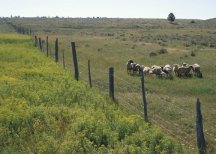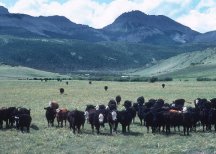Previous Page | Right click this page to print.
Cultivated Pasture and Rangeland Forages
The first portion of the section will discuss a few of the management issues for cultivated or seeded pastures. Regarding forage species, in general, for cultivated pastures, grass-legumes mixtures are recommended.
Cultivated pastures require provision of adequate moisture to the forage.
Often, adequate moisture is provided via irrigation of the pastures. Management
of irrigation systems requires consideration for factors such as the method
and frequency of irrigation, amount of moisture per application, and removal
of excess moisture (i.e. field drainage).
In addition to irrigation management, irrigated pastures require a higher
level of fertility to maximize yield and nutritional value. The type and
amount of fertilizer applied is dependent upon plant species and production
objectives. In general, the three main nutrients to consider are nitrogen,
phosphorus, and potassium. In grass-legume pastures, nitrogen will promote
grass growth and phosphorus will promote legume growth. In addition, as
forage mineral composition is influenced by the composition of the soils,
consideration should be given to minerals deficient in the specific soils.
To maximize profitability from a pasture with a high yield and nutritional
value, it is recommended to graze the pasture with high-producing animals.
Examples of high producing animals include lactating and growing cattle
and sheep. Supplementation of the forage may also be required to maximize
the nutritional value of the forage and improve animal production. Pastures
maintained in a vegetative state, especially grass-legume mixtures and
legumes, have a high crude protein content. In addition, the energy content
of the forages is low relative to the protein. As described earlier, efficient
synthesis of microbial crude protein requires a synchronization of a nitrogen
and an energy source. Therefore, to improve microbial crude protein synthesis
and animal production, animals consuming forages with a high protein content
are often supplemented with an energy source.
Rangelands are large, naturally vegetated land areas.
Figure 8.14 illustrates sheep on a rangeland.

The range is managed with a rotation grazing system.
Figure 8.15 illustrates cattle grazing a rangeland.

In general, the vegetation consists of relatively low densities of grasses,
legumes, forbes, and browse. Rangeland vegetation includes a combination
of native and introduced species. In the U.S., the majority of rangelands
are west of the Mississippi River. In addition, the majority of rangelands
in the west are owned and administered by the United States Federal Government.
In comparison to cultivated pastures, in general, rangelands are less
productive regarding yield and nutritional value of forage and are more
difficult to manage. In addition, rangelands are often used for multiple
purposes such as wildlife production. The yield and nutritional value
is less due, in part, to the inherent properties of the vegetation and
the rangeland ecosystem such as forage species, topography, soil and environmental
conditions, and previous use of the rangeland. In comparison to cultivated
pasture forages, antinutritional factors are a more valid concern for
rangeland forages. The specific antinutritional factor(s) varies across
plant species and the concentration of the antinutritional factor varies
with factors such as soil and environmental conditions. As a forage manager,
it is important to know the potential species, the species’ antinutritional
factors, factors influencing the concentration of the antinutritional
factor, and to manage to reduce the opportunity for toxicity such as by
providing adequate forage. In general, the economic losses are greater
for decreases in production versus death of animals.
Management of the rangeland requires management of the interrelated factors
of forage, animal, and rangeland systems. Management includes consideration
for factors such as forage species, yield, nutritional value, and season
available, appropriate stocking rate, distribution, and supplementation
of animals, improvement of the resource, etc. Selection of animal species
is dependent upon economic factors and range factors such as vegetation,
water, topography, and predators. An effective management scheme may include
common or dual use of the rangeland; the use of more than one species
in the grazing system. As a result of the different preferences for forage
species, portions of the forage, terrain, temperature, and distance from
water between animal species, to achieve maximum forage utilization rangelands
and cultivated pastures may be grazed by more than one species. Preferences
for forage species vary with season and stage of maturity of the plant.
In general, cattle are classified as nonselective grazers and prefer grasses
and forage legumes. In contrast, sheep and goats are classified as selective
grazers and will consume greater amounts of forbes and browse. To determine
the appropriate extent of defoliation, the 50-50 rule is a good rule of
thumb. According to the 50-50 rule, in the heavily grazed areas, graze
50% of the weight of the forage and leave 50% of the weight of the forage.
Application of the rule will promote future forage production. The 50-50
rule can also be applied to cultivated pastures. Grazing according to
season of use is also important for animal and future forage production.
Season of use is determined by factors such as vegetation, topography,
and climate. To describe season of use, rangelands are classified into
spring-fall, winter, spring-fall-winter, and summer categories.
Improvement on rangelands is more complex than improvement on cultivated
pastures. Indicators of rangeland degradation include a decrease in favorable
forage species, an increase in unfavorable forage species, and an increase
in erosion. Animal management practices to improve the rangeland include
practices such as conservative stocking rates, appropriate seasonal use,
and proper distribution of animals on the rangeland. Methods to improve
animal distribution on the rangeland include use of a rotational system,
use of fencing, herding, provision of additional water sources, appropriate
location of supplemental feeds, controlling pests, and building trails
to inaccessible portions of the rangeland. Additional rangeland improvement
practices include reseeding and brush and weed control.
The principles of the grazing systems for rangelands are similar to the
grazing systems for cultivated or seeded pastures. The following discussion
will focus on a few of the features of range grazing systems. On ranges,
the most common grazing system is the continuous grazing system. For a
continuous system, grazing management is achieved via controlling stocking
rate and animal distribution on the range. The advantages of a continuous
grazing system are: 1) more efficient on less productive ranges; and 2)
more practical for seasonal ranges. The disadvantages of a continuous
grazing system are: 1) lower animal stocking rate; 2) lower animal production
per unit area; 3) poorer animal distribution; and 4) less opportunity
to use range improvement techniques. In general, forage and animal productivity
are maximized, as well as the wildlife habitat and water resources are
more effectively preserved, with a rotational system. For ranges, the
two primary types of rotational grazing systems are deferred rotational
and short duration grazing systems. For the deferred rotational systems,
the season of grazing and resting periods for each pasture will vary from
year to year.
Figure 8.16 illustrates a deferred rotational grazing system.

The figure also illustrates placement of supplement and water to improve
animal distribution. Short duration rotational grazing systems involve
frequent movement of animals between small pastures. The frequency of
animal movement is dependent upon the availability of the forage; the
more forage available, the more frequent the animal movement. Two short
duration rotational grazing systems are the rectangular and the cell grazing
systems.
Generally, the nutrients provided in the rangeland forage do not fulfill
the nutrient requirements of the animal and therefore supplementation
is required. The type and level of supplementation varies depending on
the specific animal requirements and nutritional value of the forage.
Supplementation will also vary by season and by year. In general, the
nutrient(s) provided in a supplement are energy, protein, minerals (especially
phosphorus), and vitamins (especially vitamin A). Energy supplementation
may be required when the availability of forage is low, digestibility
of the forage is low, opportunity for nitrate toxicity is high, or energy
to protein ratio is low. In general, energy supplementation should be
on a daily basis. In general, protein supplements are the largest supplement
cost for producers. In addition to provision of protein, protein supplementation
also improves utilization of additional nutrients. Protein supplementation
can be provided every other day or twice per week. Additional feedstuffs
may be added to the supplement to limit consumption. Typically, supplementation
of macrominerals, microminerals, and vitamins is accomplished with the
use of a carrier.
Previous Page | Right click this page to print.